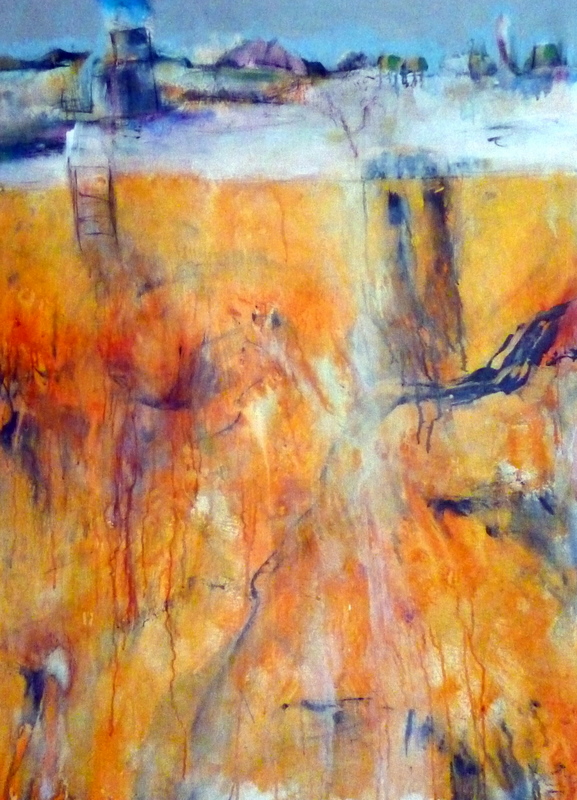The world’s oldest painting is now found to be an abstract red “dot” or circle dated reliably back to 40,000 BCE. This makes it older than the previously dated Chauvet Cave paintings so eloquently documented by Werner Herzog. It’s also provoked speculation that Neaderthals may have been artists– the ultimate reversal of art from highbrow to lowbrow. Or perhaps abstraction is, once again, seen as “lower” art, thus the Neanderthal question… just kidding. Sort of. You can see the red area and the mouth-blown hand stencils below.

The work, age-verified last year in a series of North Spanish caves, seems to be a mixture of abstraction, hands, and animals. The figures below are called “seals”. Huh? Maybe. Or maybe female figures with a vulva mark at the end… or, even, abstractions. There is an assumption that the abstract is more primitive and came before the figurative, but if the exquisitely worked animals of Chauvet are only a thousand years off, I think it’s likely that all the styles, including the popular figuative animals, existed simultaneously, as they do today.

Here are horses, almost always found paired with aurochs. Look at the cute little zebra leg. It’s easier to love the horsie than the red dot, except for abstract fans. You have to interpret the dot yourself.
Let’s hear it for the red dot! A red circle is primal, like the sun, like hands, like animals.
A red dot also means the painting sold! Do you think it means he sold his wall of marks? Here’s my red dot– Over Underworld, a meditation on cave paint, civilization, and what’s underneath. You can see it during ARTrails this October in Studio 92. I hope to see you in my cave then. 
News Release on World’s Oldest Art
Ancient drawings discovered in Spain have been crowned the world’s earliest cave art. Scientists claim the images date back 40,800 years and may have been done by Neanderthals. The find in 11 caves in northern Spain has beaten the previous record held by Chauvet cave in central France, which boasts drawings of animals thought to date back 39,000 years. Scientists say Spain’s cave art is now the oldest known in Europe, and probably the oldest in the world. The drawings feature animals, round red dots and a series of handprints known as a Panel of Hands. “We find one of these [handprints] to date older than 37,300 years on the Panel of Hands, and very nearby there is a red disc made by a very similar technique that dates to older than 40,800 years,” Dr. Alistair Pike, archaeological scientist from Bristol University explained to reporters. Working in the caves, scientists had to solve the difficult task of dating the ancient images. Pike explained that unlike bones or tools that can be carbon-dated and associated with artifacts found nearby, cave art is “not associated with anything but itself.” The team of scientists used a special technique to date the drawings. They analyzed the calcite patinas that form with mineralized water dripping over the art for thousands of years, just like stalagmites and stalactites form in caves. Over time, the calcite accumulates naturally occurring radioactive uranium from the water. Uranium atoms with years decay into thorium at a very precise rate. The ratio of the two different elements in a sample forms a so-called clock that can determine the sample’s age quite accurately.



I love your painting. Tells the whole story. As for the cave, remains of an ante-deluvian summer camp art class? The doilies and leather belts didn’t survive…
LikeLike
Moo Goo, doilies are eternal. Good to hear from you, and thanks for reading!
LikeLike
I tire of the so-called division between Neanderthals (as primitive beasts) and Homo sapiens (as human and therefore intelligent.) And it seems that scientists are slow to recognize that we, as beings — including our Neanderthal ancestors — make art. Art making is our first impulse……it is what we do. But scientists almost seem surprised……Yes, people like the horses rather than the abstract….. the abstract (and abstract thought) is more difficult…. Your article makes me want to crawl around southern France and northern Spain visiting caverns, caves and grottoes…..Brava……
LikeLike
I hear that now certain DNA tests can tell you how much Neanderthal ya got in ya! I bet artists have more than their share.
LikeLike
I got me some neanderthal! A good bit!
:-). 23 and me DNA test. Fun.
LikeLike
I do believe it!
LikeLike